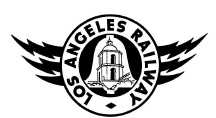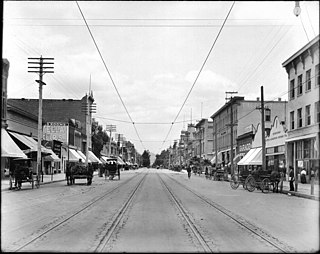Related Research Articles

Redlands is a city in San Bernardino County, California, United States. As of the 2020 census, the city had a population of 73,168, up from 68,747 at the 2010 census. The city is located approximately 45 miles (72 km) northwest of Palm Springs and 63 miles (101 km) east of Los Angeles.

The Pacific Electric Railway Company, nicknamed the Red Cars, was a privately owned mass transit system in Southern California consisting of electrically powered streetcars, interurban cars, and buses and was the largest electric railway system in the world in the 1920s. Organized around the city centers of Los Angeles and San Bernardino, it connected cities in Los Angeles County, Orange County, San Bernardino County and Riverside County.

The Los Angeles Railway was a system of streetcars that operated in Central Los Angeles and surrounding neighborhoods between 1895 and 1963. The system provided frequent local services which complemented the Pacific Electric "Red Car" system's largely commuter-based interurban routes. The company carried many more passengers than the Red Cars, which served a larger and sparser area of Los Angeles.

The East Bay Electric Lines were a unit of the Southern Pacific Railroad that operated electric interurban-type trains in the East Bay region of the San Francisco Bay Area. Beginning in 1862, the SP and its predecessors operated local steam-drawn ferry-train passenger service in the East Bay on an expanding system of lines, but in 1902 the Key System started a competing system of electric lines and ferries. The SP then drew up plans to expand and electrify its system of lines and this new service began in 1911. The trains served the cities of Berkeley, Albany, Emeryville, Oakland, Alameda, and San Leandro transporting commuters to and from the large Oakland Pier and SP Alameda Pier. A fleet of ferry boats ran between these piers and the docks of the Ferry Building on the San Francisco Embarcadero.

The Monrovia–Glendora Line was a route on the Pacific Electric Railway serving the San Gabriel Valley. It operated from 1902 to 1951, supporting nearby real estate development.

Glendale–Burbank is a defunct Pacific Electric railway line that was operational from 1904 to 1955 in Southern California, running from Downtown Los Angeles to Burbank via Glendale. Short lines terminated Downtown and in North Glendale, including the popular Edendale Local.

The Pasadena Short Line was a passenger railway line of the Pacific Electric Railway. It ran between Downtown Los Angeles and Downtown Pasadena, California, through Eastside Los Angeles along the foot of the eastern San Rafael Hills to the western San Gabriel Valley. It was in service under the company between 1902 until 1951, though it had operated under different companies back to its beginnings as a horsecar line. The route, designated by the company as line 2, was the key component of the company's Northern Subdivision.

The Upland–San Bernardino Line was an interurban line operated by the Pacific Electric Railway between Downtown Los Angeles and San Bernardino, California. This line also had shorter service that terminated before the end of the line at Baldwin Park, Covina, and San Dimas. Though service along this line in its entirety was discontinued in November 1941, it stands as the fourth-longest rapid transit line in American history, after the Sacramento Northern Railway's Chico and Colusa services, and the Pacific Electric's own Riverside–Rialto Line.

The South Hollywood–Sherman Line was a suburban route of the Pacific Electric Railway. The line ran between Downtown Los Angeles and the suburb of Sherman. The line was named after Moses Sherman, who built the line and the Sherman street car yard on the line in West LA. The large 5.56-acre (2.25 ha) rail facility was on Santa Monica Boulevard just west of La Cienega Boulevard. The yard had a steam power house, a car barn and a shop building.

The Owensmouth Line was a Pacific Electric interurban service that connected the San Fernando Valley to Downtown Los Angeles. The route was largely developed as the result of real estate speculation.

The Hollywood Line was a local streetcar line of the Pacific Electric Railway. It primarily operated between Downtown Los Angeles and Hollywood, with some trips as far away as Beverly Hills and West Los Angeles. It was the company's busiest route prior to the opening of the Hollywood Subway. Designated as route 32, the line operated from 1909 until 1954.

The Long Beach Line was a major interurban railway operated by the Pacific Electric Railway between Los Angeles and Long Beach, California via Florence, Watts, and Compton. Service began in 1902 and lasted until 1961, the last line of the system to be replaced by buses.

The Los Angeles Pacific Railroad (1896−1911) (LAP) was an electric public transit and freight railway system in Los Angeles County, California. At its peak it had 230 miles (370 km) of track extending from Downtown Los Angeles to the Westside, Santa Monica, and the South Bay towns along Santa Monica Bay.

The Redlands Central Railway Company car barn is a historic car barn located at 746 East Citrus Avenue in Redlands, California, United States. The building was used to house electric railway cars, first for the Redlands Central Railway and later for the Pacific Electric Railway. It is the only extant Pacific Electric car barn, and one of only two trolley barns remaining in Southern California.

The San Bernardino–Riverside is a former Pacific Electric (PE) interurban railway line in the Inland Empire. Unlike most of the company's services, trains did not travel to Downtown Los Angeles and instead provided a suburban service between San Bernardino and Riverside.

The Redlands Line is a former Pacific Electric interurban railway line in the Inland Empire. The route provided suburban service between San Bernardino and Redlands.

The Riverside–Arlington Line is a former Pacific Electric interurban railway line in the Inland Empire. The route provided suburban service between San Bernardino and Arlington with a later extension to Corona. It operated between 1893 and 1943.
The Pomona–Claremont Line was a Pacific Electric streetcar line in Southern California. Unlike most of the company's services, cars did not travel to Downtown Los Angeles and instead provided a suburban service between Pomona, Claremont, and Upland.
The Pacific Electric Railway established streetcar services in Long Beach in 1902. Unlike other cities where Pacific Electric operated local streetcars, Long Beach's system did not predate the company's services. Long Beach's network of streetcars peaked around 1911 with over 30 miles (48 km) of tracks throughout the city. Local services were discontinued in 1940, but interurban service to Los Angeles persisted until 1961. The route of the former main interurban line was rebuilt in the late 1980s as the Metro Blue Line, which operates at-grade with car traffic for a portion of its length.

San Pedro featured a network of streetcars between 1903 and 1958. The establishment of the Port of Los Angeles in the early 1900s spurred the development of the nearby city, and electric streetcars provided local transit services for workers and later military personnel. Pacific Electric was the primary operator in the city.
References
- ↑ Swett 1967 , p. 34
- 1 2 "First Redlands street car began service May, '89". Redlands Daily Facts. November 13, 1968. p. 47. Retrieved November 29, 2022– via Newspapers.com.

- 1 2 3 Burgess & Gonzales 2004 , p. 70
- ↑ "The Redlands Street Railway..." The Citrograph. March 29, 1890. p. 7. Retrieved November 29, 2022– via Newspapers.com.

- ↑ Swett 1967 , p. 35
- ↑ "Historic Redlands Lighting System Today 50 Years Old - Street Illumination Proved Feasibility Of World's First Long Transmission Line". The San Bernardino Daily Sun. Vol. 49. San Bernardino, California. August 6, 1943. p. 12.
- ↑ Moore, Frank; Moore, Bill (December 27, 1967). "With A Grain of Salt". Redlands Daily Facts. p. 16. Retrieved November 29, 2022– via Newspapers.com.

- ↑ "Shake! Redlands ain't you glad?". The San Bernardino County Sun. March 10, 1903. p. 1. Retrieved November 28, 2022– via Newspapers.com.

- ↑ Swett 1967 , p. 54
- 1 2 3 Muckenfuss, Mark (July 24, 2015). "Last remnant of the red cars". The Press-Enterprise . Archived from the original on August 18, 2016. Retrieved October 18, 2016.
- ↑ Crump 1977 , p. 65
- ↑ Swett 1967 , p. 235
- ↑ Burgess & Gonzales 2004 , p. 71
- ↑ Crump 1977 , p. 95
- 1 2 3 Veysey 1958 , p. 53
- 1 2 Veysey 1958 , p. 54
- ↑ Veysey 1958 , p. 66
- ↑ "Pacific Electric San Bernardino Line". www.erha.org.
- ↑ "Rail Service On Interurban Lines Dropped - Abandonment Effective Monday Of Car Service; Busses To Be Substituted". The San Bernardino Daily Sun. San Bernardino, California. July 19, 1936. pp. 13, 23.
- ↑ Swett 1967 , p. 85
- ↑ "Late Mail To Result From P.E. Stoppage". The San Bernardino Daily Sun. San Bernardino, California. July 19, 1936. p. 15.
- ↑ "Groundbreaking Held For Redlands-To-San-Bernardino Rail Line". Redlands-Loma Linda, CA Patch. July 22, 2019.
- ↑ MacDuff, Cassie (May 16, 2011). "Imperfect Rail Solution". The Press-Enterprise . Riverside, California: Press-Enterprise Corporation. Archived from the original on February 24, 2015. Retrieved November 5, 2011.
- ↑ "Redlands celebrates completion of Arrow passenger rail line". Redlands Daily Facts . Ron Hasse. October 21, 2022. Retrieved October 24, 2022.
- ↑ Asperin, Alexa Mae (October 24, 2022). "Metrolink's new 'Arrow' train service from Redlands to San Bernardino begins". KTTV . Fox Television Stations . Retrieved October 24, 2022.
Bibliography
- Burgess, Larry E.; Gonzales, Nathan D. (2004). Redlands. Arcadia Publishing. ISBN 9780738528830.
- Crump, Spencer (1977). Ride The Big Red Cars: How Trolleys Helped Build Southern California. Corona Del Mar, CA: Trans-Anglo Books. ISBN 978-0-87046-047-0. OL 4560875M.
- Swett, Ira (August 1967). "Tractions of the Orange Empire", Interurbans Special #41. Los Angeles, CA: Interurbans. OCLC 4310467.
- Veysey, Laurence R. (June 1958). A History Of The Rail Passenger Service Operated By The Pacific Electric Railway Company Since 1911 And By Its Successors Since 1953 (PDF). LACMTA (Report). Los Angeles, California: Interurbans. ASIN B0007F8D84. OCLC 6565577.
